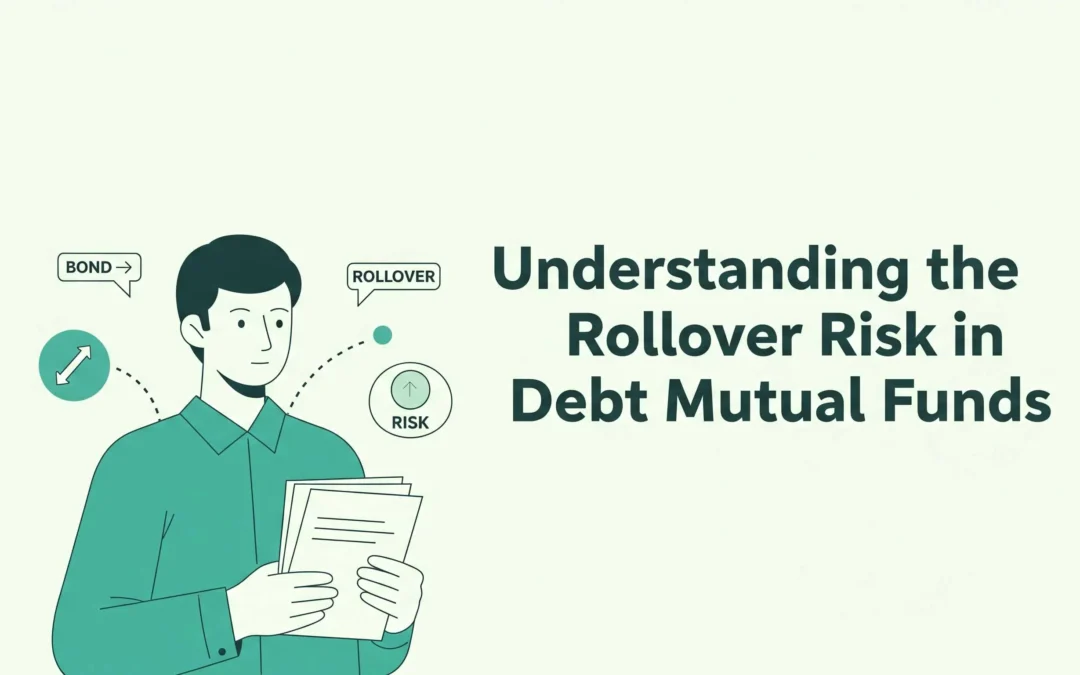Debt mutual funds have traditionally been a go-to for individuals who want to minimize their risk or avoid risky trades with their investments. They’re all about getting steady income and keeping your initial money secure.
These funds put your cash into stuff like company bonds, government securities, and treasury bills. Now, while they’re usually not as wild as stock market funds, don’t kid yourself – they’re not completely risk-free. And one of those less talked about, but growing, risks with debt mutual funds is something called “rollover risk”.
What Is Rollover Risk?
Rollover risk, sometimes called refinancing risk, pops up when a fund (or even a borrower) has to pay off old debt that’s coming due, but they can’t get new loans on good terms – or worse, can’t get them at all.
Now, when we’re talking about debt mutual funds, here’s how it plays out: These funds often put money into investments that mature pretty soon. When that happens, the folks who issued those investments need to “roll over” or renew their debt. But if the market goes south, or if the issuer’s financial health takes a hit, they might have a tough time issuing new debt to pay back the old stuff. This can leave the fund in a tricky spot.
This becomes problematic for mutual fund managers, especially if a large portion of the fund’s portfolio is invested in short-duration instruments that depend on frequent refinancing by the issuers.
How Does Rollover Risk Work in Practice?
Let’s start with an example: Consider a debt mutual fund that’s invested in a pile of “commercial papers” issued by a “Non-Banking Financial Company (NBFC)”, and these are all coming due in roughly half a year. Typically, these sorts of investments offer pretty good returns and usually just get “rolled over” or renewed without a hitch.
But what if that NBFC suddenly runs into a cash crunch? Or maybe the overall market sentiment shifts – perhaps there’s a big problem in that entire sector, or the economy just starts to slow down.
In such a scenario, the NBFC might struggle to get new money to pay back those maturing papers. And that’s where the fund could face a problem.
In that case, the mutual fund is stuck holding a security that may default or face delayed payments. Investors in the fund may witness a decline in net asset value (NAV), and if the fund comes under pressure, there could be a surge in redemptions. In extreme situations, the fund might even impose temporary restrictions—commonly called gating on withdrawals, meaning investors may not be able to close their positions or withdraw their money for a period
Why Is Rollover Risk Often Overlooked?
“Rollover risk” usually flies under the radar; it’s not as flashy or obvious as “interest rate risk” or “credit risk”.
- Think of it as a quiet problem that brews in the background, especially when there’s plenty of money flowing through the market and borrowing is easy.
- A lot of individuals who invest in debt funds, especially everyday investors like you and me, just assume that every bond in a fund’s portfolio will get paid back when it’s due.
- They often miss the fact that some companies might just keep refinancing their debt over and over again, rather than paying it off.
- Sometimes, even the individuals running these funds, whether they realise it or not, can leave their portfolios vulnerable to this risk.
It often happens when they’re trying to snag those higher returns by putting money into lower-rated or short-term debt from companies that aren’t exactly rock-solid financially.
What Influences Rollover Risk?
Rollover risk is influenced by several market and issuer-specific factors:
- Market Liquidity: In times of financial stress, when money gets tight or the central bank cranks up interest rates, cash just isn’t as easy to come by.
- Issuer Credit Profile: Considering that Companies with poor fundamentals and balance sheets or struggling cash flows are more vulnerable to rollover risk.
- Regulatory Changes: A sudden shift in regulations can shake up a company’s ability to refinance, and policy changes would affect the cash flow in the sector, which would eventually affect the sector’s development.
- Macroeconomic Events: As the global financial crisis, pandemics, or even war scenarios are created, which would result in huge uncertainty everywhere, it would end up affecting the market.
How Can Investors Mitigate Rollover Risk?
Ways for investors to protect themselves from Rollover Risks:
- Diversify Across Duration and Quality: Diversify the portfolio into different sectors, which would cause a big loss or a blood bath in your holdings.
- Examine Portfolio Holdings: Check if the fund holds a lot of papers maturing in the near term from issuers known to rely on rollovers, be aware of the news, or the decision taken by your holding positions. This data is publicly available in the fund’s monthly fact sheet.
- Stick to High-Quality Funds: Funds that invest in high-credit-quality instruments such as AAA-rated bonds or government securities have lower risk and, along with believing in quality, not just the quantity of the undervalued stocks.
- Understand Fund Type and Strategy: Credit risk funds, while they flash those potentially bigger returns, actually carry a good deal more rollover and credit risk. If you are not ready for the higher risks, it could be better to stick to less volatile options like liquid funds, banking & PSU debt funds, or short-duration funds, especially those with straightforward strategies.
- Track Exit Loads and Lock-In Periods: As you start investing, it is very important to know when to stop, so tracking your exit is important, as after the risk-reward ratio is maintained, to know when to exit.
Final Thoughts:
As an investor, it all comes down to finding that sweet spot between “risk and return”. Stay in the know and try not to get carried away chasing high yields without really understanding what you’re getting into. Debt funds offer a lot of great benefits, but just like any investment, they need careful selection and ongoing attention.
Ultimately, your best protection against rollover risk–or any risk, for that matter–is being “informed and vigilant”.
Written By: Shivayogi Angadi


